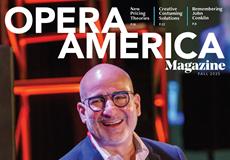Opera leaders discuss strategies for combatting high staff turnover
The times when people were committed to decades-long allegiances to their employer are gone. According to the U.S. Bureau of Labor, a record 50.5 million Americans quit their job in 2022 during the so-called “Great Resignation,” when employees quit en masse to find jobs that better aligned with their priorities and sense of balance after the forced downtime of the pandemic. That exodus has affected the arts with particular severity.
For opera staff, working during the day to prepare for an evening’s performance and clocking in regularly on evenings and weekends can take a toll over the years. Many performing arts organizations have reported turnover rates in the 20–40% range on an annual basis — some have even reached 50% — as many former employees shift to jobs with higher pay, more comprehensive benefits, and more flexible schedules. For a concrete example, OPERA America’s job board postings have spiked from just under 100 in 2018 to nearly 1,000 in 2022. “The notion of a traditional work-life balance is fundamentally challenged by the way the arts are produced,” says Marc A. Scorca, president and CEO of OPERA America.
The increased turnover can make it tougher to boost organizational morale. It makes it difficult to build institutional memory and synergy, and it complicates organizations’ efforts to build long-term relationships with donors and funding organizations. In short, it makes it tough to get into an operatic “groove.” There is no one-size- fits-all solution to the current turnover rate, though industry professionals are advocating a variety of strategies to smooth out some of the turbulence caused by high churn and to build workplaces that attract longer-term employees.
LISA SWAIN:
Transparent values
Arts organizations have long recruited employees in part by appealing to their mission and artistic reputation. That may no longer be enough: “Opera companies can no longer start out by saying, ‘Come work for us because we are the opera company that’s performing at the highest quality in our city,’” says Lisa Swain, executive director of member services and operations for Advisory Board for the Arts. “There are other things that matter now.”
Things like salary, vacation, and healthcare have always been a part of the hiring equation. Now, however, employment data and surveys are indicating that an arts organization’s mission and reputation matter less to employees than they did prior to the pandemic. This is not true for everyone — there are still many individuals who prioritize supporting the art form. “Employees want to trust that a company has done its due diligence to determine salaries,” Swain says. And, Scorca adds, some of the softer elements of an employee package need to be on full display from the beginning, things like time off during slower months of the year to make up for the busy season.
TIMOTHY O’LEARY:
Reducing micromanagement
Like their for-profit counterparts, most arts organizations typically operate with a “top-down” flow chart that has a clear chain of command. But opera is a business that at times requires improvisation and autonomy at the front lines. According to Timothy O’Leary, general director of Washington National Opera, there’s nothing that frustrates people in the arts more than feeling they can’t do their best work because they are being micromanaged.
He has worked to empower his employees — both artists and staff — who interact directly with the public so that they can make decisions on their own. “Instead of ‘top-down,’ you think ‘front-to-back,’” he explains, adding that he sees his position as director as a supporting role for the employees at the public front of the organization. When employees feel trusted and empowered, that’s when they become capable of performing at their best.




ANDREW MORGAN:
Succession Roadmaps
In the spring of 2021, Andrew Morgan, the general director of Hawai‘i Opera Theatre, lost his directors of production, marketing, and development during the same month. The production director had meticulous files about the job, and the marketing director wrote an eight-page bible for his successor. But the development director left no such documentation and departed before completing applications for government and foundation funding. Morgan stepped in to help get the new employee up to speed, but there was a degree of reinventing the wheel: “We both created and recreated processes along the way,” he recalls.
Morgan advises that keeping notes on day-to-day tasks and best practices should be one of the annual goals and objectives of all employees and an integral part of their performance review. Without these documents, onboarding takes longer and expectations for job tasks may not be clear, which can be frustrating and inefficient at a time when many companies are constantly hiring new employees. Preparing these notes can be time-consuming or feel low-priority, and Morgan suggests framing the need for succession documents not as a way to cover the company’s bases in case of an abrupt departure, but instead as top executives respecting the work of their employees enough to ask them to document their tasks.
MARC A. SCORCA:
Proper Onboarding
There is a tendency in the arts to expect new staff and newly promoted employees to be fully productive on day one of their new roles. Even with a succession document, this is unrealistic, says Scorca. He recommends a lesson from the corporate sector by dedicating the first week of employment to casual, informational meetings with staff to absorb the history and culture of the organization — before jumping into the work. This process can be enriched by thoughtful “pre-boarding” before the new staff member’s first day in the office. Welcoming emails from staff, a few gift certificates to local restaurants, and a copy of the company staff manual mailed in advance can be early indications of caring management. Proper onboarding and a spirit of bonding won’t pay the bills or student loan debt, but it can help make people feel more purposeful in their work, and feeling a sense of belonging and purpose can help encourage employees to remain in their roles.
Non-artistic employees, like accountants and IT professionals, for example, have reported feeling secluded from the art that happens onstage. And for those with such in-demand skills, it’s common for better-paying corporations to snatch them up. Dedicated onboarding time in the form of introductory meetings and informal lunches or happy hours can revitalize the staff and rekindle a sense of purpose that is essential for the arts. “How do we create a team spirit for kindness within the organization and find time for folks to affirm our shared love of opera?” Scorca says. “We must be fully cognizant of the mission of the company and the way it’s improving life in the community.”
This article was published in the Fall 2023 issue of Opera America Magazine.

Esteban Meneses
Esteban Meneses is a freelance arts and music writer based in Orlando and is a contributing writer and assistant editor at I Care If You Listen.






